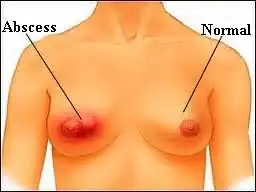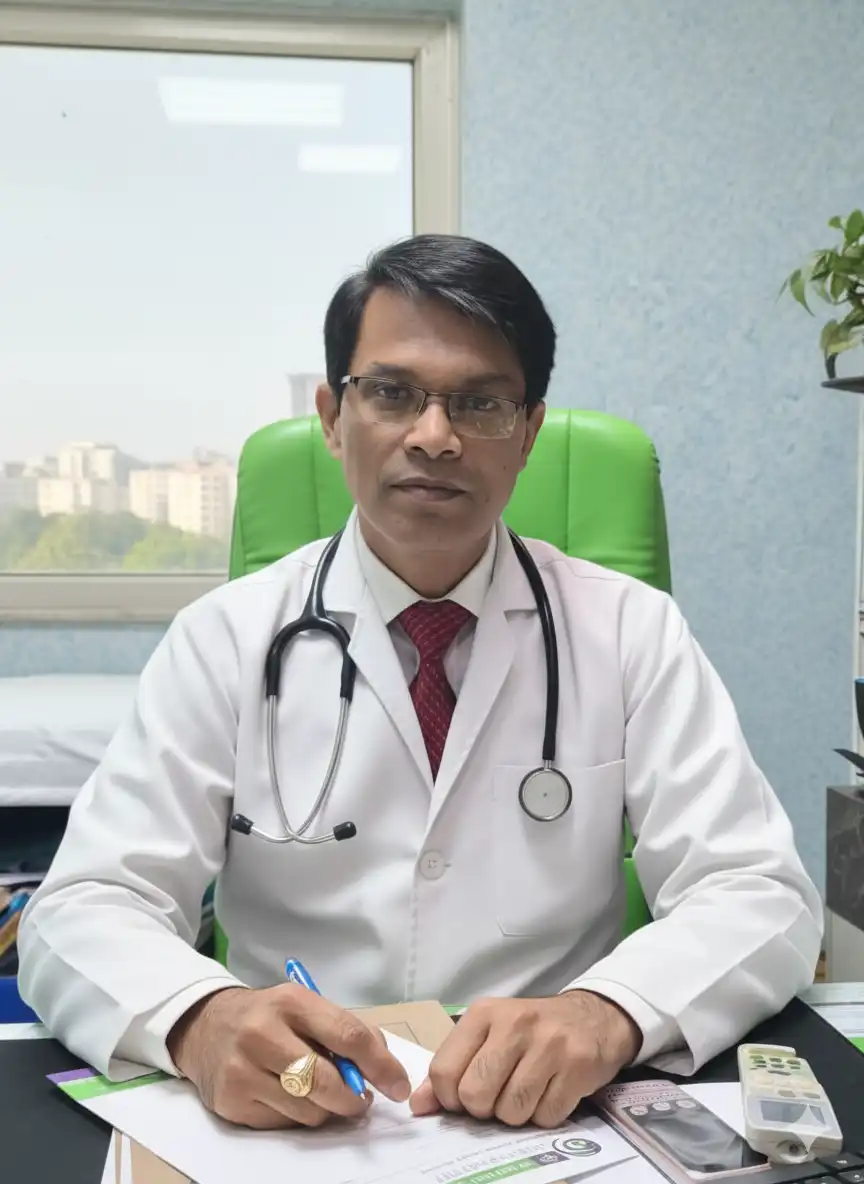
What is a Breast Abscess?
A breast abscess is a localised collection of pus that forms inside the breast tissue due to infection. It is most commonly seen in breastfeeding women, though it can also occur in non-lactating women and rarely in men. The infection usually develops when bacteria enter through cracks or breaks in the skin or nipple. The immune system sends white blood cells to fight the infection, leading to pus accumulation. The abscess feels like a painful, swollen lump, often accompanied by redness, warmth, and tenderness. Prompt medical attention is essential to relieve pain and prevent complications.

What are the symptoms of a breast abscess?
A breast abscess usually presents as a painful lump within the breast that feels firm or soft depending on pus collection. The area may be swollen, red, and warm to the touch. Throbbing or sharp pain is common, often worsening during movement or breastfeeding. Fever, chills, and fatigue may accompany the infection. In some cases, pus may leak from the nipple or skin. The breast can feel heavy and tender, making feeding difficult. Unlike simple mastitis, an abscess produces a more localised, persistent lump that does not improve with antibiotics alone.
What causes a breast abscess?
A breast abscess develops when bacteria invade breast tissue, usually through damaged skin or nipple cracks. The most common culprit is Staphylococcus aureus. Breastfeeding women are more prone because milk stasis and nipple injuries provide a favourable environment for infection. Other risk factors include smoking, diabetes, weakened immunity, nipple piercings, and poor breast hygiene. Sometimes mastitis, if untreated, can progress into an abscess. In non-lactating women, blockages in breast ducts or trauma may also play a role. Understanding these causes helps in preventing and treating the condition effectively, reducing the chance of recurrent abscesses.
How is a breast abscess diagnosed?
Diagnosis of a breast abscess begins with a detailed clinical examination. The doctor checks for swelling, warmth, and tenderness. An ultrasound is often used to confirm the presence of a fluid-filled pocket and to distinguish an abscess from a solid mass or tumour. Sometimes, needle aspiration is performed to draw out pus for both diagnosis and relief. Blood tests may also show elevated infection markers. In non-lactating women or those with recurrent abscesses, further imaging, like mammography, may be recommended to rule out underlying conditions. Early and accurate diagnosis ensures faster treatment and prevents complications.
Can a breast abscess turn into cancer?
A breast abscess does not turn into cancer. They are separate conditions. However, because both may present as a lump in the breast, proper diagnosis is important. Persistent or recurrent abscesses in non-lactating women can sometimes mask underlying breast diseases. This is why doctors often recommend imaging or biopsy if there are suspicious features or poor healing. While abscesses themselves are not cancerous, ignoring them may delay the diagnosis of other conditions. Any unusual lump, non-healing infection, or bloody discharge should always be evaluated to ensure breast health and rule out cancer.
What is the difference between a breast abscess and mastitis?
Mastitis is an inflammation of the breast, usually due to milk stasis or infection, and often occurs in breastfeeding women. Symptoms include redness, swelling, pain, and sometimes fever. If mastitis is not treated promptly, it can progress into a breast abscess, which is a localised collection of pus. The key difference is that mastitis is diffuse inflammation, while an abscess forms a distinct lump filled with pus. Mastitis may respond to antibiotics and home care, but an abscess typically requires drainage. Recognising this difference is important for timely and appropriate treatment.
How can I prevent a breast abscess?
Prevention involves reducing risk factors. For breastfeeding women, frequent feeding, ensuring correct latch, and fully emptying the breasts help prevent milk stasis and infection. Keeping nipples clean and dry reduces the chances of cracks and bacterial entry. Warm compresses and gentle massage may help with blocked ducts. Avoiding smoking and maintaining good general health lowers the risk in both lactating and non-lactating women. Diabetics should keep their blood sugar under control. Wearing comfortable bras and maintaining proper hygiene also helps. Early treatment of mastitis or nipple injury prevents abscess formation and ensures healthy breast function.
When should I see a doctor for a breast abscess?
You should consult a doctor if you notice a painful, swollen lump in your breast, especially if it is red, hot, or associated with fever. Any persistent breast pain, pus discharge, or worsening symptoms despite home remedies require medical attention. Breastfeeding mothers should not delay, as untreated infections can interfere with feeding and worsen quickly. Non-lactating women should be cautious, as abscess-like lumps could mimic other serious conditions. Prompt medical evaluation ensures timely treatment, reduces pain, and prevents complications such as spreading infection or recurrence. Early consultation is always safer.
What are the complications of a breast abscess?
If left untreated, a breast abscess can lead to serious complications. The infection may spread to surrounding tissues, causing cellulitis or sepsis in severe cases. Recurrent abscesses can result in chronic scarring, duct damage, or deformity of the breast. For breastfeeding mothers, pain and discomfort may lead to early weaning or difficulty feeding. Rarely, untreated abscesses can mimic or mask underlying conditions like inflammatory breast cancer, delaying proper diagnosis. Surgical scars from repeated drainage may also affect cosmetic appearance. Early treatment is essential to prevent these complications and ensure faster recovery.
Treatment of Breast Abscess through Homoeopathy
Homoeopathy offers a gentle and effective approach in managing breast abscesses. While surgical drainage or antibiotics may be needed in advanced cases, homeopathic medicines can help in:
- Reducing pain, swelling, and tenderness
- Controlling infection and preventing pus accumulation.
- Promoting healing of the affected breast tissue.
- Preventing recurrence by addressing the underlying tendency to infections.
- Supporting breastfeeding mothers by ensuring safe medicines without harm to the baby.
Commonly prescribed homeopathic medicines (chosen after detailed case-taking):
- Belladonna – for sudden, red, hot swelling with throbbing pain.
- Hepar sulph – when aan bscess is forming with sharp, sticking pain.
- Silicea – for chronic or recurrent abscesses, helps in expelling pus.
- Phytolacca – for breast pain and abscess related to lactation.
- Bryonia – when breast pain worsens with the slightest movement.
The exact remedy and potency are selected only after a personalised consultation, as homoeopathy treats the individual, not just the disease.
Why choose Dr. Sanjay Homoeopathy for Breast Abscess treatment in Lucknow, India?
Dr. Sanjay’s Homoeopathy is a trusted clinic for safe and effective Breast Abscess treatment in Lucknow, India. With his years of expertise, Dr Sanjay is the top doctor for breast abscess treatment in Lucknow, India, and provides specialised homeopathic treatment that helps reduce pain, swelling, pus formation, and breast tenderness naturally, without side effects. As a leading homeopathic doctor in Lucknow, he follows international treatment standards and offers personalised care that addresses the root cause of Breast Abscess while boosting immunity and promoting faster healing. Patients choose Dr. Sanjay’s Homoeopathy for its holistic healing, long-lasting relief, and compassionate approach in managing breast health conditions like Breast Abscess.
Patients from across the world trust Dr. Sanjay’s Homoeopathy for Breast Abscess treatment in Lucknow, India. Dr Sanjay Singh, who led this clinic, has successfully treated thousands of patients with Breast Abscess, making him the best doctor for Breast Abscess treatment in Lucknow, India.
